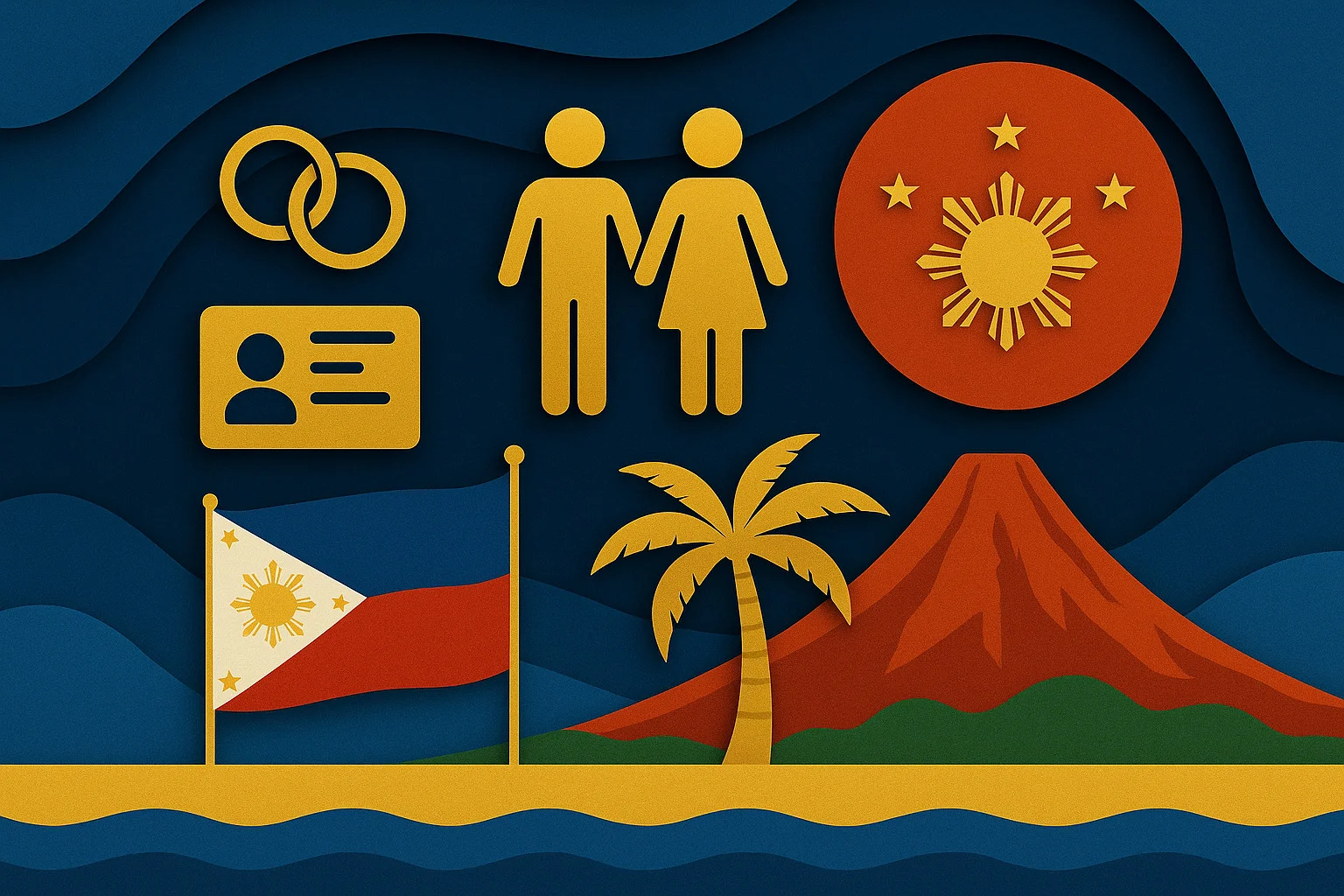Philippines citizenship in 2026 — naturalisation, marriage & descent
120
10/1/2025

Philippines citizenship in 2026 — naturalisation, marriage & descent
Philippine citizenship grants full political rights, long-term security for your family, and a stable base in a dynamic ASEAN economy. Lawful routes include naturalisation after residence, marriage to a Filipino citizen, citizenship by descent, birth and adoption in defined cases, and rare humanitarian or merit-based grants. Still building eligibility? Secure the right residence route first and keep your timeline clean in our companion guide on Philippines residence.
Key terms
Naturalisation: acquisition of Philippine citizenship after long-term lawful residence, integration and good character checks.
Citizenship by descent: recognition of citizenship through a Filipino parent (or, in specific cases, grandparent) based on jus sanguinis.
Marriage route: eligibility for foreign spouses of Filipino citizens; marriage does not grant citizenship automatically but can shorten residence and support naturalisation.
Reacquisition / retention: procedures allowing eligible former Filipino citizens to regain or retain citizenship under defined conditions.
Oath of allegiance: final step where citizenship is conferred upon swearing allegiance.
Dual citizenship: allowed in defined cases; whether you may keep your other nationality depends on both legal systems.
Citizenship types
- Naturalisation: The main route for long-term foreign residents who can show continuous lawful residence, good moral character and integration into Philippine society. Language ability for daily life, understanding of local norms, tax compliance and clean criminal records are assessed. Successful applicants attend an oath ceremony where citizenship is conferred.
- Marriage: Foreign spouses of Filipino citizens may qualify after a period of genuine marriage and cohabitation in the Philippines. Authorities require proof of a real family life — joint address registration, financial interdependence and, where applicable, children. Marriage helps eligibility but does not automatically confer citizenship; applicants still complete naturalisation formalities.
- Descent (by blood): Children of Filipino citizens typically acquire citizenship at birth, including those born abroad. Adults with a Filipino parent (or qualifying grandparent under specific provisions) may apply for recognition of citizenship by descent, submitting consistent civil records and legalised certificates. Verification is strict to prevent fraudulent lineage claims.
- Birth in the Philippines: The Philippines applies limited jus soli to prevent statelessness. Foundlings and children of unknown or stateless parents born on Philippine territory may obtain citizenship. Ordinary births to foreign parents follow descent rules rather than territorial birthright.
- Adoption: Minors fully adopted by Filipino citizens may obtain citizenship once adoption is legally finalised and recognised by competent authorities. This route focuses on the child’s best interests and the validity of adoption across jurisdictions.
- Reacquisition / retention for former citizens: Former natural-born Filipinos who lost citizenship by acquiring another nationality may be eligible to reacquire or retain it under defined procedures. This involves documentary proof of prior Philippine citizenship and an oath of allegiance, restoring full rights while often allowing dual nationality.
- Exceptional merit / public interest: In rare cases, citizenship may be granted to individuals with outstanding contributions to the Philippines — for example in public service, science, culture or national development. These awards are discretionary and require high-level approval.
- Investment: There is no direct citizenship-by-investment program. Investors typically follow the track of residence or permanent residence first; after sustained economic contribution and integration, they may pursue naturalisation through ordinary procedures.
- Humanitarian grounds: Citizenship may be granted in exceptional humanitarian circumstances, such as long-term statelessness. Decisions are discretionary and evidence-intensive.
Routes & timelines
| Route | Eligibility highlights | Indicative timeline |
|---|---|---|
| Naturalisation | Long-term residence, integration, clean record | ≈18–24 months |
| Marriage | Genuine marriage & cohabitation with Filipino citizen | ≈12–18 months |
| Descent recognition | Filipino parent (or qualifying grandparent) | ≈6–12 months |
| Reacquisition/retention | Former Filipino with sufficient proof | ≈1–3 months |
| Adoption | Minor fully adopted by Filipino citizen | Immediate upon recognition |
| Humanitarian/merit | Exceptional public interest grounds | Case-specific |
Step-by-step
- Confirm eligibility: verify residence years, marriage/cohabitation records, or descent/adoption documents. Former citizens compile proof of prior Philippine citizenship.
- Prepare integration proofs: language for daily life, knowledge of civic norms, tax compliance, and community ties.
- Collect documents: passport, residence card if applicable, birth/marriage/adoption certificates, police clearances from all recent countries of residence, and financial stability evidence.
- File application: submit your dossier to competent authorities (national or regional) following the route-specific forms and procedures.
- Background checks: authorities verify criminal and security records and may invite you for an interview to assess integration and good character.
- Decision & oath: if approved, attend the oath of allegiance ceremony and receive your certificate of citizenship.
Documents
Typical sets include passport, residence evidence (if applicable), birth and marriage certificates, adoption orders, police clearances, proof of prior Philippine citizenship for reacquisition, and integration evidence (language, community, tax). All foreign records must be legalised and translated into English. Need certified translations or apostille wording? Use our legal & business translation support to match local filing requirements.
Costs
Budget for filing fees, translations and legalisation, background checks, and optional legal representation. Amounts vary by route (naturalisation, descent recognition, reacquisition), and fees are periodically indexed. Explore tools, checklists, and case studies on our Residency & Citizenship section to plan your application end-to-end.
Integration
Citizenship decisions weigh more than residence length:
- Language ability for everyday communication and public services.
- Compliance with Philippine laws and taxes; clean criminal and immigration record.
- Community ties such as family life, employment, education or volunteering.
- Clear intention to maintain a genuine link with the Philippines.
Insufficient integration evidence is a frequent reason for delay or refusal even if eligibility years are met.
What changed in 2026
Key 2026 developments include streamlined digital intakes for select routes, clearer templates for descent recognition files, and enhanced cohabitation evidence standards for marriage-based cases. Authorities also emphasised timely responses to document requests during security checks.
Did you know?
Reacquisition procedures enable many former Filipinos to restore citizenship while maintaining their other nationality where permitted by law — a practical option for diaspora families managing careers across countries.
Common mistakes
- Assuming marriage alone grants citizenship — you must still qualify and complete naturalisation or registration steps.
- Submitting incomplete genealogical chains for descent recognition.
- Ignoring requests for additional evidence during security checks.
- Using translations without legalisation or incorrect apostille wording.
- Letting residence permissions lapse before filing for naturalisation.
- Expecting citizenship by investment — no direct program exists.
- Not preparing for interviews assessing language and integration.
- Failing to include police clearances from all recent countries of residence.
- Overlooking proof of prior Philippine citizenship in reacquisition cases.
- Not updating authorities about address or marital status changes during processing.
FAQ
Does marriage to a Filipino citizen grant automatic citizenship?
No. Marriage supports eligibility but you must still apply and meet integration and good character requirements.
How long does naturalisation take?
Typical timelines are about 18–24 months due to background checks and oath scheduling.
Can former Filipino citizens regain citizenship?
Yes, eligible former citizens may apply for reacquisition or retention, usually with an oath of allegiance and proof of prior status.
Do I need to renounce my current nationality?
It depends. The Philippines allows dual citizenship in defined cases; check your other country’s rules.
What proves descent?
Consistent civil records linking you to a Filipino parent (and, where relevant, grandparent), legalised and translated.
Is there a language test?
Language for daily life may be checked via interview or documentation; prepare practical proficiency.
Where do I submit my application?
At the competent national or regional authority following route-specific instructions.
Can adopted children obtain citizenship?
Yes, minors fully adopted by Filipino citizens can be recognised once the adoption is finalised and registered.
Will investment speed up citizenship?
No. There is no citizenship-by-investment; economic contribution supports residence, not direct nationality.
What if I lived in several countries?
Provide police clearances from all relevant jurisdictions to avoid delays or refusals.
Expert opinion
Philippine citizenship rewards precise documentation and early planning: align your residence history, document cohabitation or descent carefully, and treat translations as core evidence, not an afterthought. Well-prepared files clear faster and avoid rework.
— Rafael, Global Visa Consultant, VelesClub Int.
Next steps
Have questions about timing, translations, or integration? Get a free consultation with VelesClub Int. Start at our main platform or go directly to the Residency & Citizenship section — and continue to the companion article.
Are there any questions or do you need advice?
Leave a request
Our expert will contact you to discuss tasks, choose solutions and be in touch at each stage of the transaction.
